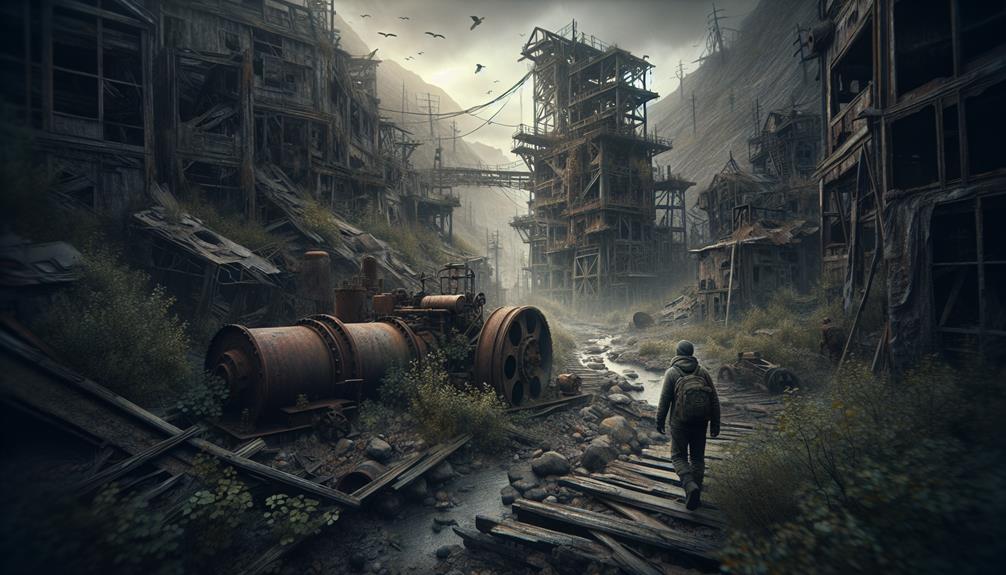Embark on a journey through forgotten oil towns to uncover mysteries and history. Consult historical maps and urban explorers for hidden gems. Wear sturdy footwear, bring a flashlight, and pack a first aid kit for safety. Witness the prosperity and relics of these towns. Preserve the legacy with strategic efforts. Explore tales of hope, despair, and resilience. Step into the past and grasp its insights. Adventure into these abandoned towns to uncover the secrets they hold; each step reveals more than meets the eye.
Key Points
- Research historical maps and archives for town locations.
- Equip with sturdy footwear, flashlight, and first aid kit.
- Understand the history and stories of abandoned towns.
- Prioritize safety and awareness when exploring ruins.
- Implement preservation efforts to protect ghost town legacy.
Locating Forgotten Oil Towns
To begin your search for forgotten oil towns, start by consulting historical maps and archives. Urban exploration enthusiasts like yourself often seek out these hidden gems for the thrill of uncovering the past. Geocaching can also be a useful tool in locating these historical sites, as many geocachers hide caches in or near these abandoned towns, leading you right to them.
Historical maps provide valuable clues to the locations of these towns, often marked as settlements that have since been forgotten. Archives hold even more detailed information, including photographs, records, and sometimes firsthand accounts of what life was like in these oil boom towns.
Safety Precautions for Exploration
When planning your exploration of abandoned oil towns, prioritizing safety is crucial to a successful and secure adventure. As you journey into these forgotten locations, keep these exploration tips and emergency preparedness measures in mind:
- Exploration Tips
- Always wear sturdy footwear to protect your feet from debris and sharp objects.
- Carry a flashlight or headlamp to navigate dark interiors and underground areas.
- Stay aware of your surroundings, watching for unstable structures or hazardous materials.
In the event of an emergency, being prepared can make all the difference. Pack a basic first aid kit, water, and snacks in a backpack for easy access. Additionally, inform someone of your exploration plans and expected return time. Remember, safety should always take precedence when undertaking these thrilling excursions into the past.
Packing Essentials for Ruins Exploration
Prioritize your safety and enhance your exploration experience by packing essential gear for ruins exploration. When venturing into deserted oil towns, having the appropriate exploration gear can make all the difference.
First and foremost, a sturdy pair of hiking boots is vital to protect your feet from dangerous debris and uneven terrain. Additionally, a headlamp or flashlight is necessary for finding your way in poorly lit structures and underground passageways.
Carrying a first aid kit is non-negotiable. You never know when minor injuries might occur, so being prepared can prevent complications. Packing lightweight snacks and water will help sustain your energy levels during long treks through abandoned buildings and desolate streets. A multi-tool can also be a lifesaver in unexpected situations, allowing you to make quick repairs or alterations as needed.
Lastly, honing basic survival skills such as map reading, fire starting, and emergency signaling is invaluable. By equipping yourself with these essentials, you'll be well-prepared to tackle the challenges of exploring deserted oil towns while staying safe and making the most of your adventure.
Understanding the History of Abandoned Oil Towns
Uncover the rich and intriguing history behind abandoned oil towns, delving into the stories of prosperity, decline, and the remnants left behind. During the oil boom, these towns thrived with bustling activity and rapid growth, attracting people from far and wide in pursuit of wealth and opportunity. However, as quickly as they rose to prominence, many of these towns faced economic decline, leading to their eventual abandonment. Exploring the history of these ghost towns can provide valuable insights into the past and a deeper appreciation for the resilience of the human spirit in the face of adversity.
- Boom and Bust: Witness the rapid expansion and prosperity that characterized these oil towns during the boom years.
- Abandoned Relics: Discover the eerie remnants of a bygone era, from dilapidated buildings to rusting machinery scattered across the landscape.
- Lost Stories: Unearth the tales of hope, despair, and resilience that once echoed through the streets of these now-deserted settlements.
Preserving the Legacy of Ghost Towns
To guarantee the lasting legacy of ghost towns, it's important to implement strategic preservation efforts that safeguard their historical significance for future generations. Historical preservation plays a crucial role in maintaining the authenticity and charm of these abandoned settlements. By conserving the structures, artifacts, and stories of ghost towns, we make sure that their rich history isn't lost to time.
Urban exploration enthusiasts often find themselves drawn to these eerie yet captivating places. The allure of walking through streets frozen in time and uncovering the secrets of the past is a powerful motivator. Preserving the legacy of ghost towns allows for continued exploration and discovery, offering a glimpse into a bygone era.
Through careful restoration and documentation, we can protect the unique character of these ghost towns while making them accessible to those who seek to understand their significance. By embracing historical preservation practices, we can guarantee that these abandoned oil towns remain a testament to the human experience, serving as reminders of our shared heritage.
Frequently Asked Questions
Are There Any Regulations or Permits Required to Explore Abandoned Oil Towns?
You don't need permits to explore abandoned oil towns, but safety precautions are essential. Historical preservation is key; be mindful of the environment and engage with the community. Respect the past while treading lightly.
How Can One Differentiate Between a Safe Structure to Explore and One That Is Too Dangerous to Enter?
When exploring, trust your instincts. Look for signs of decay like cracked walls or sagging roofs. Use caution near dilapidated areas. Prioritize safety precautions by evaluating risks. Identify hazards to avoid dangerous structures.
Are There Any Specific Legal Considerations to Keep in Mind When Exploring Abandoned Oil Towns?
When exploring deserted oil towns, remember legal considerations. Respect environmental impact and conservation efforts. Be mindful of historical preservation and urban exploration regulations. Stay informed to guarantee your adventures are both safe and respectful.
As you venture through the rugged landscape around abandoned oil towns, be wary of wildlife encounters. To navigate safely, equip yourself with sturdy boots, a map, and a keen eye for terrain challenges. Stay alert.
How Can One Respectfully Interact With Any Remaining Artifacts or Structures in These Ghost Towns?
When exploring abandoned oil towns, remember artifact preservation and ethical exploration. Show historical sensitivity by respecting structures. Follow photography etiquette to honor the past. Engage with the remnants of these ghost towns with curiosity and care.



